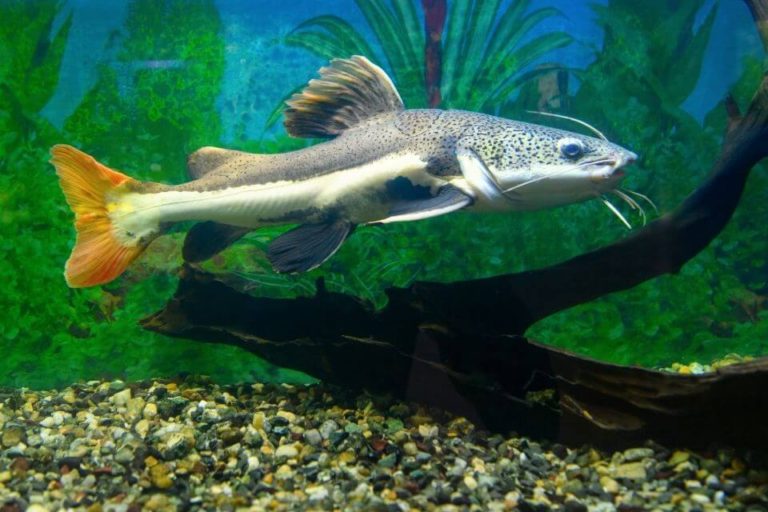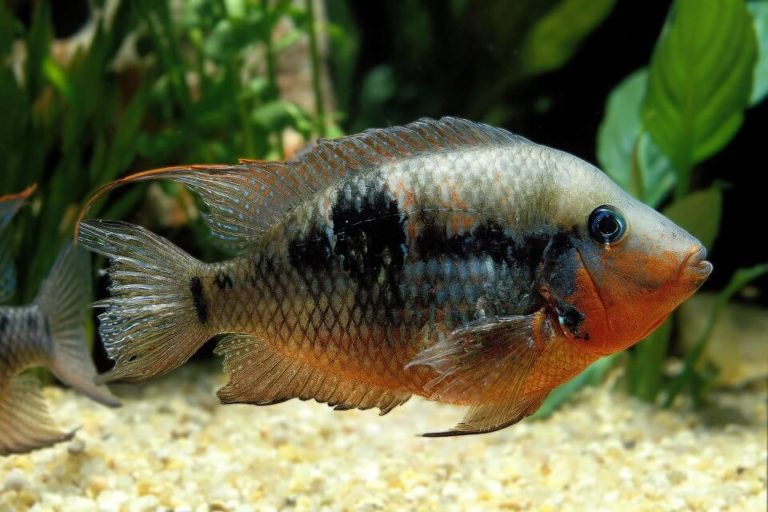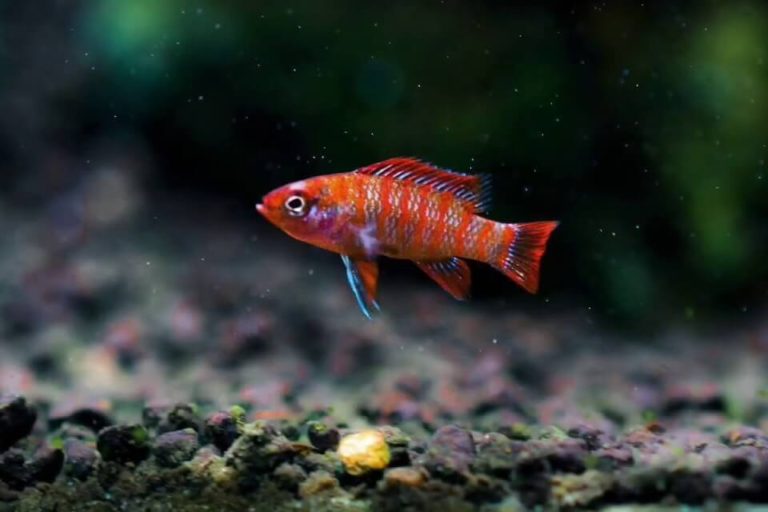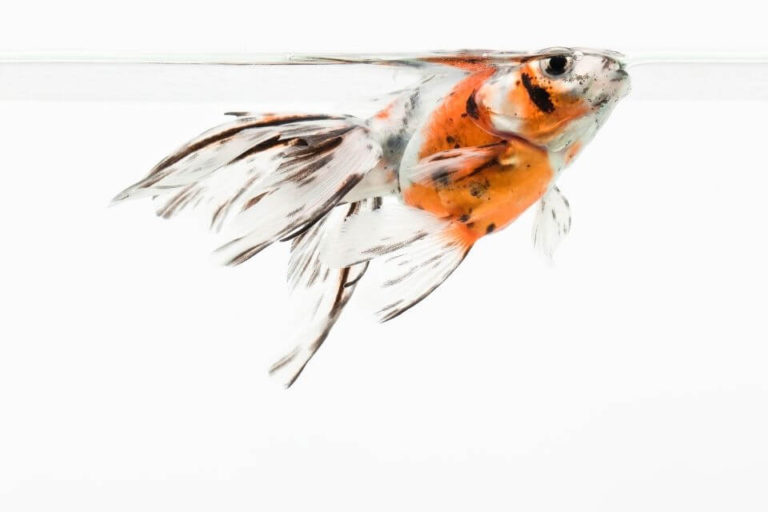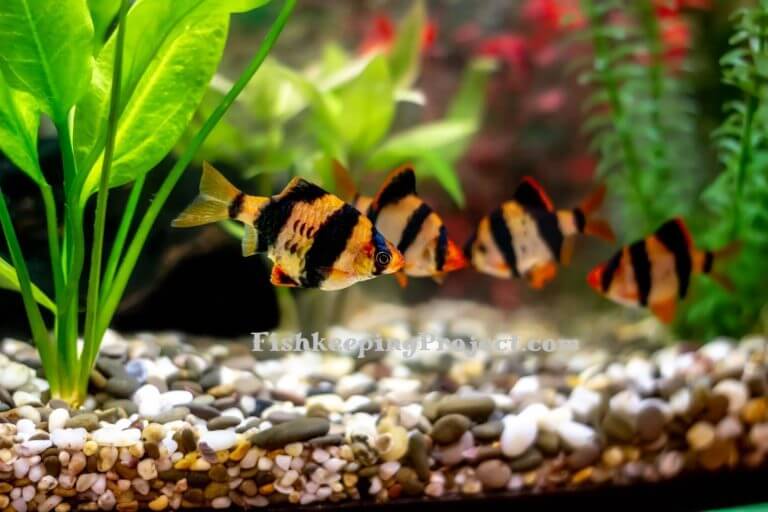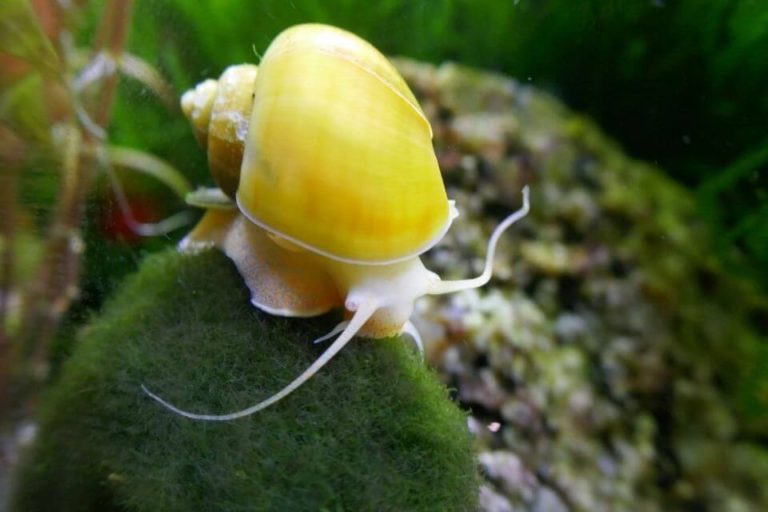German Blue Ram Care: Size, Lifespan, Diet, Tank Mates, Tank Size, More

German Blue Ram fish (Rum Cichlid) is a small freshwater fish species of Cichlid that are native to the Orinoco River basin of Venezuela and Colombia.
The species has been introduced into Mexico, Trinidad, Peru, Guyana, Aruba, Puerto Rico, and the USA lately to use in freshwater aquariums. The German Blue Ram is a popular aquarium fish and the most common species of its genus.
This fish is a fantastic Cichlid that forms deep bonds with its owner. This article will provide you with all of the information you need for German Blue Ram care in your home or community aquarium.
Species Overview
German Blue Ram Cichlid is made up of three very distinctive subspecies that are distinguishable by color. They are all very beautiful fish, and they are very peaceful. They make excellent additions to any aquarium of 20 gallons or more.
German Blue Ram Cichlid (scientifically known as Mikrogeophagus ramirezi) is a peaceful fish that lives well with other South American Rams and many different types of tropical community fish. This makes them a very popular choice for community aquariums.
The German Blue Ram is filled with vibrant colors that we all love, and they have an extremely strong personality. They are constantly exploring their environment and getting into trouble around the tank.
This is what makes these rams such a joy to own! They will do well in any aquarium that has plenty of rocks and roots for them to explore.
German Blue Ram Size
In the wild, German Blue Ram size can grow up to 4 inches long over time which is quite small for a freshwater Cichlid. In captivity, they can grow between 2 to 3 inches long which is not very big.
The peaceful nature and the German Blue Ram size made them a great addition to community aquariums.
German Blue Ram Lifespan
A healthy German Blue Ram lifespan is up to 5 years in the wild. A German Blue Ram lifespan is in a captivity environment will usually have less than wild breeds’ lifespan.
It is important to keep their water clean and give them plenty of places to hide and explore. In captivity, German Blue Ram lifespan of around 3 to 4 years as well if given them well-managed care.
Behavior & Temperament
The German Blue Ram is known for having the personality that every other Cichlid wishes they had. They are constantly exploring their environment and getting into trouble around the tank which makes them very enjoyable to watch.
They are also very easy-going fish species which makes them a great addition to any community aquarium. The German Blue Ram Cichlid is also known for being very peaceful.
So they can live with many different types of community fish without any issues at all. These Ram fish will do well in any aquarium that has plenty of rocks and roots for them to explore and provide cover.
They also do very well with many different types of tropical community fish. When the German Blue Ram is first added to their aquarium, they will usually become very shy and stay hidden for a few days while they adjust the new tank.
Because of their peaceful nature, they are generally considered community fish because they can be kept with any other fish as long as you make sure that both the Ram and the other species of fish are compatible with each other.
Appearance And Colors
The German Blue Ram fish has a bright neon blue color, and they have a large golden mask that covers their entire face. This mask makes them the perfect fish to own if you are looking for a great show-quality Cichlid.
These Ram species also have beautiful blue coloration on their dorsal fin, pelvic fins, and ventral fins. It can grow up to a decent size in a captivity environment which is quite large for a freshwater fish species.

They have a very thin body and a big mouth with a flat bottom. They also have two incredibly long filaments on their dorsal fin that extend out from the back of their head.
You will find the Electric Blue Ram Cichlid variety which is one of the color variations of the Ram Cichlid species. This Electric Blue Ram Cichlid has their entire body in bright blue color that has a very attractive appearance.
Electric Blue Ram Cichlid has no difference that regular Ram Cichlid and they have the same characteristics as the regular Rams.
German Blue Ram Care
The German Blue Ram fish is a great Cichlid for beginners and experienced Aquarists alike because they are so easy to care for. They have simple needs that can be easily met in most aquarium setups if you give them the attention that they need.
– German Blue Ram Tank Size
The minimum German Blue Ram tank size is 20 gallons tank is generally enough space for single German Blue Ram Cichlid. But larger tanks are preferred if you like to add tank mates and decorations to your aquarium.
You can add aquarium plants to make them feel secure since they do not like bright lights or open spaces. When you place them with some other tank mates, you should go with a tank of 40 gallons.
They can live comfortably in an aquarium this size for their entire life if you make sure the water is clean and provide them with plenty of hiding spots.
– German Blue Ram Tank Setup
When setting up the tank for German Blue Ram fish, it is very important to have lots of rocks and decor that enable them to use as hiding places. Using sand substrate is reasonable to make them feel in the wild.
They are used to living in flooded savannas that are surrounded by thick vegetation. Having a tank with plenty of plants, driftwood, rocks, and roots will make them feel right at home.
Adding plenty of live aquarium plants will also help create a more natural environment for your fish. Some other things you should have in your fish tank are a good aquarium water filter, water heater, and a tank lid.
The filter is very important because these fish are generally quite messy eaters, which means that it will not take long for their aquarium to get dirty if you do not change the water frequently.
You should also make sure that the heater is capable of heating the entire tank to maintain the tropical water temperature. It is a must to have a thermometer in your fish tank so that you can test the temperature regularly.
If possible, try to get an aquarium with a black water extractor since they will love playing in it and exploring all around it. If not, you can add a sponge filter or under gravel filter if you want to make sure they always have good water circulation.
– Water Conditions And Parameters
Since the German Blue Ram Cichlid is native to areas that have a very low pH, it is important to mimic their natural habitat when setting up your tank by keeping the water conditions and parameters just like they would be in nature.
This means having the below requirement will be an ideal living environment for you Ram species.
- Temperature: 74 – 82 °F (22 – 26 °C)
- Acidity levels: 5 – 7 pH
- Water hardness: 4 – 10 dGH
– Suitable Aquarium Plants
The German Blue Ram is large enough to rearrange the rocks and decor in the tank by their daily activities, so they can be quite unsafe for Live Aquarium Plants in the aquarium.
Artificial aquarium plants are much safer because the rams will not uproot them or cause any damage to them.
TIP: Using live plants in your aquarium is optional, and you can use artificial plastic plants. But unlike plastic plants, live plants maintain the water freshness by adding oxygen, utilizing nitrates, and removing carbon dioxide from the water. Hence the live aquarium plants are recommended.
– Possible Diseases And Prevention
The German Blue Ram is generally hardy, and they are not susceptible to many types of common fish diseases, but there are some diseases that you need to watch out for during the entire lifespan of Ram Cichlid.
One example is Pop-Eye which occurs when fluid builds up in the eyes of a fish and causes them to protrude from the eye sockets. It is usually caused by a bacterial or parasitic infection and can be prevented with proper care and medications if needed.
You should also watch out for Head, and Lateral Line Erosion (HLLE) which occurs when the head of a fish begins to lose its color and the lines on the head and body of a fish become very visible.
Head And Lateral Line Erosion happens for many different reasons, but it is always fatal if left untreated.
It can be treated with medications like Melafix or Pimafix, which are made of natural ingredients that will treat HLLE without causing any damage to your Ram.
German Blue Ram Diet And Feeding
In their natural habitat, German Blue Ram fish are opportunistic omnivores which means they will eat whatever is most readily available to them.
This usually includes insects, larvae, and pieces of fruit found on the surface of the water. Since they are omnivores in the wild, it does not mean that you should feed them an omnivore diet in your home aquarium.
If you want your German Blue Rams to be healthy and happy, then you should feed them a varied diet that contains both proteins and vegetables.
This can easily be done by feeding your German Blue Rams with brine shrimps or earthworms. Once every two(2) or three(3) days to ensure they receive all of the vitamins and minerals they need.
On the other hand, you should also be feeding them a varied diet of pellets, vegetables, and algae every day to make sure they receive all of the nutrients they need.
Fish Feeding Frequency:
As with most types of Rams, the German Blue Ram Cichlid is a messy eater and will only get messier if they are not fed often enough.
This means that their tank must be cleaned very frequently to keep it clean and healthy for both your fish and yourself. There is no need to feed them more than twice per day, but you should at least feed them once every day or two.
The feeding schedule will depend entirely on how often you clean their tank to keep it free of uneaten food and other debris.
Gender Differences
Although it is not usually possible to determine the gender of German Blue Ram fish in their early life stages, there are many physical differences between males and females when they become adults.
Males tend to be more colorful than females, with their blue stripes being much darker than the rest of the body. Additionally, males grow up to 3 inches in size while females stay around 2.5 inches long.
The most obvious difference is that the dorsal fin on adult male German Blue Rams tends to stretch out much further than on females. Even their anal fins are generally longer.
German Blue Ram Breeding
Since the German Blue Ram Cichlid is an egg-scattering species, breeding them in your home aquarium is not difficult or challenging at all if you provide them with the right conditions.
German Glue Ram breeding can be accomplished by taking a group of adult fish that are around 3 or 4 inches in size and putting them into an aquarium that is at least 20 gallons in size.
The male should then build a large bubble nest on top of the water surface, which will contain the eggs once they have been laid by one or more females.
After spawning, you should remove all other fish from the tank to avoid their eggs being eaten by other fish. Also, you should make sure to feed your German Blue Rams plenty of protein-rich foods before they spawn.
This will help improve the success rate of the fertile eggs after they are laid. The process of incubating fertilized eggs begins when the male collects them inside his bubble nest.
The male German Blue Ram will then guard the nest and the eggs until they hatch for a period of about four or five days.
Once your fry becomes free swimming, you should remove the adults to another tank so that they do not eat their offspring.
German Blue Ram Tank Mates
Since the German Blue Rams are peaceful even they grow up to be adult fish, it is recommended that you keep them with other small and peaceful fish species as German Blue Ram tank mates.
Keeping them in an aquarium that is at least 40 gallons or larger with other German Blue Ram tank mates is the bare minimum.
By keeping your German Blue Ram Cichlid in a tank that is this large, there will be plenty of room for all the fish to establish their territory without having to fight with each other.
Also, you should make sure that all of the fish are roughly the same size as the larger ones will bully or eat any smaller fish that they can fit into their mouths.
The most ideal German Blue Ram tank mates are:
- Bolivian Ram
- Rubber Lip Pleco
- Dwarf Gourami
- Opaline Gourami
- Honey Gourami
- Pearl Gourami
- Rummy Nose Tetra
- Cherry Barb
- Rosy Barb
- Corydoras Catfish
- Bristlenose Pleco
- Zebra Danio
Origin And Distribution
The German Blue Ram is native to Venezuela and Columbia. They are found throughout the Orinoco River Basin, which is where they live in flooded savannas filled with rivers, lagoons, and marshes.
These regions are also filled with very thick vegetation that provides lots of shade for them to protect themselves from predators. Their natural habitat has a very low pH which makes it extremely difficult for most other species of fish to live in.
They are very used to this type of water and can live much easier than other species in the same environment.
FAQs
Are German Blue Ram Fish Aggressive?
Although adult German Blue Ram fish are typically not aggressive towards other tank mates, they become a little aggressive when breeding and raising young.
If you decide to include your mature German Blue Rams in a community aquarium, then it is vital that you only house them with peaceful and similar size tank mates to make sure that cannot fit inside their mouths.
How Many German Blue Rams Should Be Kept Together?
Since adult German Blue Rams can become a little aggressive and territorial in the breeding season, it is best to only keep one male and a female fish per tank as they will become a pair in a 20 gallons tank.
In these cases, some German Blue Rams tend to bully instead of fighting with each other, which means you should be very careful when adding new fish to your aquarium so that you do not cause stress to your existing fish.
Can German Blue Rams Live With Shrimp?
Although there are some cases where German Blue Rams have been successful in living together with shrimp, such as Ghost Shrimp, you should avoid keeping your German Blue Rams with any type of shrimp or invertebrate.
This is because the natural behavior of adult German Blue Rams may cause them to attack and eat smaller shrimps that they encounter by mistake, which will most likely end up killing the shrimp in question.
What Is The Difference between Electric Blue Ram Vs German Blue Ram?
The most notable difference between Electric Blue Rams and German Blue Rams is the shape of their body which affects how both types of Central American cichlid are best kept in an aquarium.
For example, because they have a slimmer body that lacks any curves, Electric Blue Rams should be kept in tanks with lots of open space to move around so that they do not feel under-stimulated or become aggressive.
By comparison, since adult female and young male German Blue Rams have a large hump on their foreheads instead of a slimmer body like Electric Blues.
Electric Glue Rams require fairly small aquariums so that there is room for them to establish their territory without having to fight other fish for it.
Are German Blue Rams Schooling Fish?
Although adult male and female German Blue Ram Cichlids are typically loners that prefer to live in separate corners of the tank. They do not show any schooling behavior.
Is German Blue Ram Hardy?
Yes, it is a hardy fish. German Blue Ram fish tend to have a very high salt tolerance and will only start developing problems such as swim bladder disorders.
We recommend that you avoid keeping them in brackish water tanks because they are not ideal for living in high salt environments.
Can I Keep A Single Blue Ram?
Yes, you can have only a single German Blue Ram in a tank but, It is best to only keep one male per tank or have one male with several females.
Their relationship with other tankmates may turn aggressive if they are the only fish of their species in the tank.
This means that it is best to avoid keeping one German Blue Ram unless you plan on having them live in a very large aquarium that can accommodate more than one specimen.
Are German Blue Rams Bottom Feeders?
While many types of Cichlids swim near the top of your tank to ambush unsuspecting prey, German Blue Ram Cichlids prefer to forage the bottom of your tank for food rather than swimming at the top.
This unique behavior is very similar to that of their close relatives, the Bolivian Ram.
Where Is German Blue Ram For Sale?
You can buy a German Blue Ram fish from most local fish stores, but they are less common than other central American Cichlids, so it may be difficult to find one at your preferred store.
We recommend buying them online, where you will usually get significantly better deals on not only individual specimens but also larger quantities of fish.
How Much Does A German Blue Ram Cost?
A single German Blue Ram fish can be purchased from your local fish store for between $15 and $30, but they are less common than other Cichlids, so it may be difficult to find one at the right price.
You will get a better deal on online retailers such as Amazon and eBay. However, you should be aware that German Blue Rams and all other types of Cichlids should only be bought from reputable retailers.
Because they screen their stock for healthy specimens and guarantee them a live arrival policy.
Final Thoughts
While the information contained within this care guide provides a strong basis upon which to expand your knowledge, please remember that this is not an all-encompassing guide.
You should continue to do your research if anything here does not satiate your thirst for knowledge. I hope that you will find my site useful in some way, and good luck with your Fishkeeping endeavors.
In closing, while German Blue Ram Cichlids are a very good choice for beginners, other types of Cichlids are also common in the trade, such as Convict Cichlids and Firemouth Cichlids, just to name a few.
Be sure to check out my other articles for more information on the common Cichlids that are available at your local fish store or through online retailers like Amazon and eBay. Good Luck!


